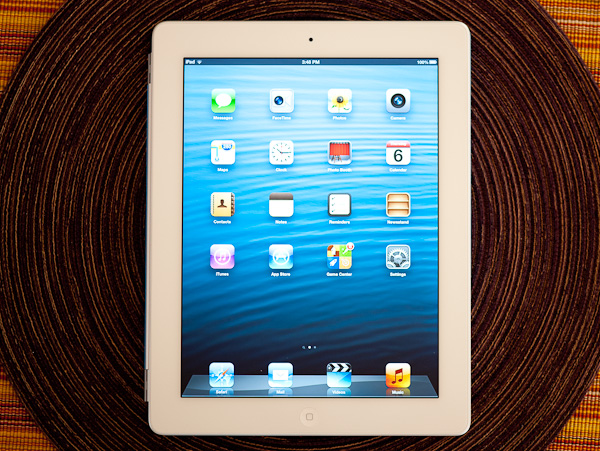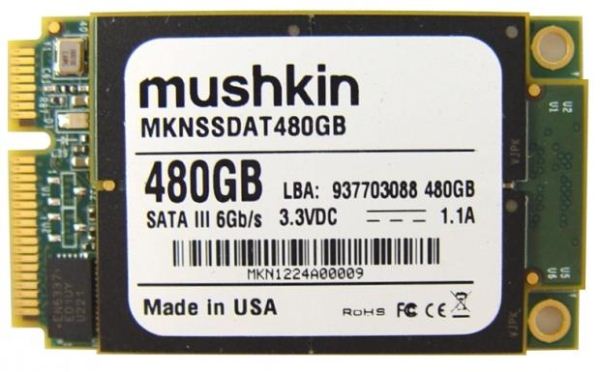AnandTech Article Channel |
- ARCHOS GamePad Introduced: 7" Gaming Tablet with Hardware Controls
- iPad 4 (Late 2012) Review
- Mushkin Announces First 480GB mSATA SSD
| ARCHOS GamePad Introduced: 7" Gaming Tablet with Hardware Controls Posted: 06 Dec 2012 05:27 PM PST Sometimes it's easier to take risks, if you aren't moving quite so many units. ARCHOS, long a player in media playback devices has spent a few years exploring Android tablets and we've put them through their paces. Their last offering was the remarkably thin 101 XS, with its impressive keyboard cover. The ARCHOS GamePad takes a rather different turn. One part tablet, one part portable game system, the GamePad brings hardware gaming controls and is available now for just 149.99 EURO, with a US release in Q1 '13.
Arranged in landscape mode, the GamePad's 1024 x 600 screen resolution isn't going to light the world on fire, but paired with the ARM Mali-400 GPU it should provide excellent frame rates. We've seen a lot of TI silicon in the last several ARCHOS tablets, so it was a surprise to see the processor go unnamed. We're still digging to find more details, but it's described as a 1.6 GHz dual-core processor, with the aforementioned Mali-400 GPU. Given the last gen nature of the GPU, I imagine that the application processor is most likely of the ARM Cortex-A9 variety, somewhat similar to a higher clocked Samsung Exynos 4210.
On the software front, this will be the first Jelly Bean tablet we've seen from ARHOS. Their software engineers have no doubt pushed themselves to the brink to bring the same media-centric features we've come to expect to, not just a new Android version, but also a new SoC. They've built a scheme for mapping the hardware buttons to soft buttons in games that aren't compatible with gamepads. So, is tablet gaming ready for a more dedicated device than we've seen in the past? We'll certainly be glad to find out. |
| Posted: 06 Dec 2012 12:40 PM PST For years, almost a decade in fact, we've been asking for higher quality displays in notebooks. With most of our pleas left ignored for the value notebook segment, smartphone and eventually tablet makers capitalized on the opportunity. These days the $399 - $499 tablet display experience tends to be superior to the $399+ notebook experience. Things are beginning to change, but not quite fast enough. At the forefront of driving tablet display performance is Apple with its Retina Display equipped iPad. While the company has never really competed in the low-cost notebook or netbook market directly, the iPad has been Apple's solution for consumers who want a computer at a $500 - $700 price point. By focusing on areas that have been neglected by PC makers in the past (e.g. display, wireless connectivity, ease of use), Apple has managed to be quite successful in this space with the iPad. As a big part of its overall strategy, Apple has done a good job of issuing regular updates to the iPad family since its initial unveil in 2010. Now, just seven months after the release of the 3rd generation iPad, Apple followed up with a 4th generation model. It's the relentless execution cycle in addition to focusing on the integration of high quality tangibles like the display that has made the iPad a formidable competitor in the $500 - $700 consumer computing space. Read on for our full review of the 4th generation iPad. |
| Mushkin Announces First 480GB mSATA SSD Posted: 06 Dec 2012 09:40 AM PST We're seeing a true shift in the mobile market to including SSDs in more of the market spectrum. What was once the domain of $1500+ laptops is now being pushed well into sub-$1000 territory, and good 128GB SSDs are generally available for under $100 now. If you need capacity, it's still hard to beat hard drives, but for fast storage SSDs are the way to go and have been for a few years. Along with the transition to faster and better SSDs, we're also seeing smaller mSATA SSDs. Up until now, the largest mSATA SSDs have topped out at 240GB/256GB, but Mushkin is now announcing their 480GB SF-2281 based Atlas mSATA drive. Ultrabooks and ultraportables in general are set to benefit from the presence of higher capacity mSATA SSDs. While many users can get by with 128GB or 256GB of storage, another class of users can routinely fill up 256GB SSDs and then some. A quick look at my Users folder on my primary desktop reveals I'm using 150GB just for my normal data (documents, images, videos, music, email, etc.) Add in my Program Files and Windows directories and that's another 80GB. Obviously I'm not a typical user, but if I were to try and go pure SSD while keeping all of my data on one drive, I'd definitely need more 256GB--and as Anand showed earlier this week, having more spare area available will only help improve the consistency of performance. Specifications for the new Atlas mSATA drive are what you would expect from a modern SandForce 480GB offering. Trim, ECC, SATA 6Gbps, upgradeable firmware, and all the other usual suspects are present. Mushkin is using "high speed MLC NAND", just like virtually every other modern consumer SSD, and the Atlas comes with a 3-year limited warranty. Max read speed is 540MBps, write is 425MBps, with 78K random read IOS and 28K random write IOPS. It uses the MO-300 mSATA form factor (50.80 x 29.85 x 4.85mm). Availability is expected in January with an MSRP of $500. That's higher than 2.5" 480GB SF-2281 drives by $50-$150, but that's the price we pay for smaller form factors. |
| You are subscribed to email updates from AnandTech To stop receiving these emails, you may unsubscribe now. | Email delivery powered by Google |
| Google Inc., 20 West Kinzie, Chicago IL USA 60610 | |


.jpg)




No comments:
Post a Comment